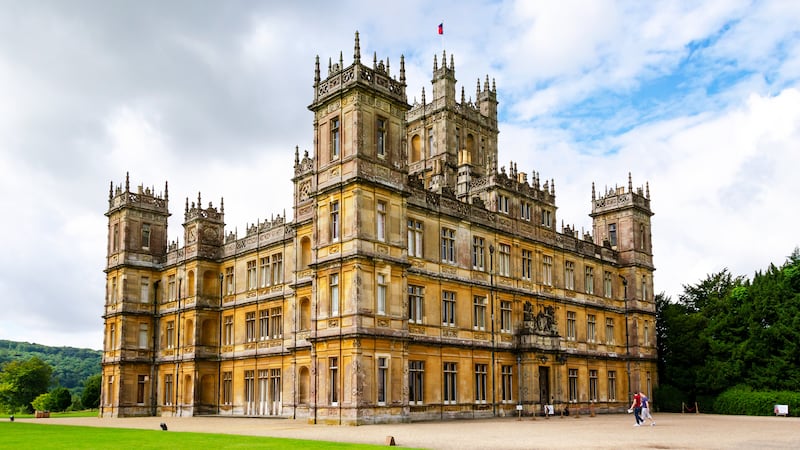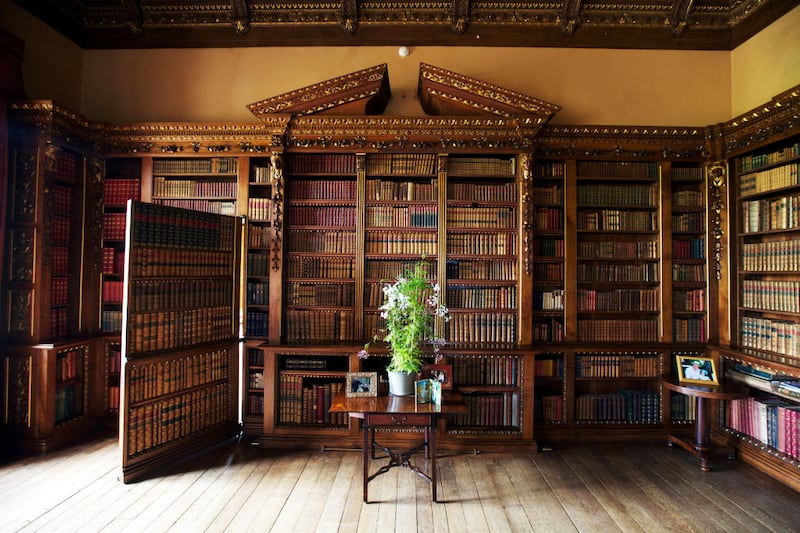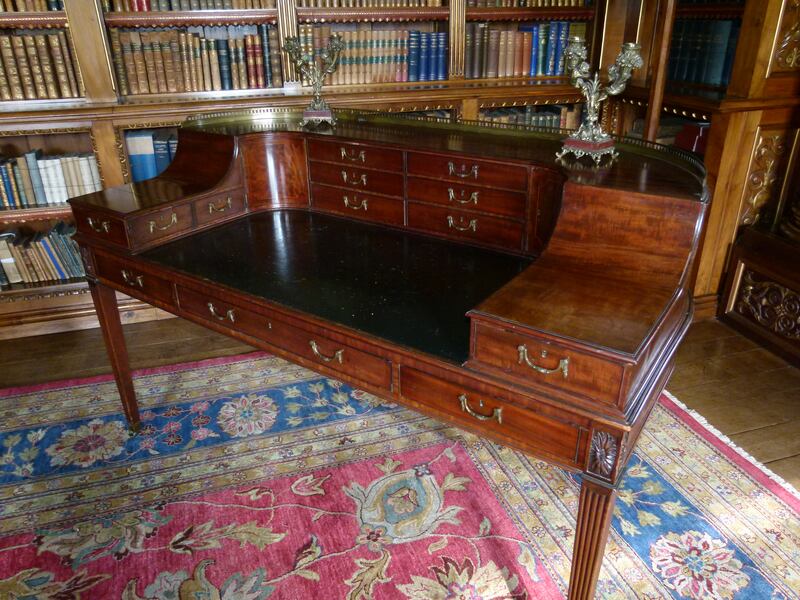As my shuttle van drove through the park gates and wound its way up Highclere Castle’s imposing driveway, the driver began playing the Downton Abbey soundtrack. While in any other circumstance this might have felt a bit too on the nose, the John Lunn-penned theme only heightened the effect of seeing the castle’s grand Jacobethan-style sweep and surreal spires for the first time. Even before exploring the library, the latest selection for The Daily Beast’s monthly series, The World’s Most Beautiful Libraries, I was swept away with the fantasy of the building I was finally seeing in person.
In person, celebrities almost universally tend to be smaller than you’d imagine. However, the Hampshire, England estate is proof that roughly £137 million can buy you plenty of room to stretch out—more than was ever documented in the PBS drawing room drama. In addition to the 300-room main house (two floors of which are open to tours), the rolling land also houses a handful of guest cottages, a chapel, immaculately sculpted gardens, and the most British of institutions—a tea house. How big, exactly, is 1,060 acres? In 1700, the owners constructed a series of follies, Greek-themed, purpose-free structures meant to take up space and draw the eye to nature. Compare that to the average flat in London, which has 43 square meters of floor space.

Highclere Castle
Brett Charlton / GettyBut it took time for Highclere to grow into the tourist hub it is now, even before visitor numbers doubled with the dawn of Downton.
In 1838, Sir Charles Barry was remodeling the Houses of Parliament in London, when he was asked to work on a private residence. Inspired by the idea of serving one family with one set of creative ideas, the architect came on board. Purchased by Sir Robert Sawyer in 1679, at the time Highclere was more a Georgian manor than palace. However, the Third Lord Carnarvon, inspired by a grand tour of Europe, was ready to rethink the size of his digs. He wanted a dramatic mix of Renaissance and Gothic architecture, which Barry delivered. And as the modern-day Lady Carnarvon tells me via a Zoom call later, a library would have been an expected feature.
“There’s been great 18th century libraries in England, and, obviously, there's been a house where Highclere stands for 400 years,” she says, noting universal respect of books goes back even further. “[Respected 16th-century bishop] William of Wykeham, one of his most important contributions was his libraries which have always been very highly valued.”
With its deep red couches, red shiraz patterned rug, ionic columns, and dark-wood bookshelves, the room has an imposing quality, underscored by the adjoining ladies’ withdrawing room, with its creamy pink couches and mint-colored wallpaper. Although Barry takes credit for exterior features of the house, it was Thomas Allom whose fingerprints are on the interior, completed after Berry’s death in 1860. Lady Carnarvon credits his touch, which can be seen in the Church of St Peter's in London, and the Ladbroke Estate in Notting Hill, for keeping the room from skewing too masculine.
“It's very much in the mode of a gentlemen's club,” she says of the library’s design, which was inspired by the Reform Club, a traditionally male-only London establishment that eventually gave women membership in 1981. “But in some ways, it was probably slightly turned away from the more loyal militaristic seeming atmosphere and devoted towards books and learning, but with a tremendous warmth to it. It doesn't get too much direct sunlight. And I think it has a balance in the room. It somehow makes it feel cozy as well despite being so large.”

A detail of the library showing a hidden door to the music room in Highclere Castle.
Matthew Lloyd / GettyIt is also, as Lady Carnarvon is apt to remind, part of a family home. This means that on days when tours aren’t active, the room doubles as an ad hoc tea salon, and also services a place where guests sip champagne during the estate’s regularly hosted public cocktail parties. But it's the books, over 6,000 of them lining the wall-to-wall shelves, that are the main focal point. They’re such a prominent design element, the secret, faux-book covered door leading into the music room (which despite its name doesn’t house so much as a tambourine), can be easy to miss.
The contents of the Highclere library run deep—although not quite as deep as Downton Abbey, where Lord Grantham casually brags to Edith about their Gutenberg Bible. Despite being organized by the Dewey Decimal System, exploring their collection has yielded plenty of surprises. There’s a large section of Egyptology books, owing to the fifth Earl of Caravan’s obsession with the country. (Finds from his multiple trips, including artifacts related to his discovery of Tutankhamun, are on display elsewhere in the castle.) An early edition of Alice and Wonderland. And the oldest book of all, a 1538 copy of Italian poet and playwright Ludovico Ariosto’ Comedia intitolata Cassaria. Although not a lending library, Lady Carnarvon sees the library as an extraordinary way to research her own books and podcast about the real lives and history surrounding Highclere, essentially gifting the public with her private cache of history.
“Whichever area of knowledge you want to explore, there's something which is simply extraordinary whether it's a book, a record, or a diary of somebody traveling around to North America, and going up the Mississippi in the 1770s,” she says. “Every single book to me is fascinating. There’s very interesting large books of actions, of records of follies, or buildings which may yet have gone. So, that's also invaluable, because some of the buildings in London or in Greece may have disappeared and collapsed by now, but we've still got some of the records of how they've been structured or what they look like. There’s old engravings of all cities or towns or villages, even of our sewer, 200 years ago. It’s the joy of any library to peruse and have a look around.”
But while the Highclere library and grounds feel like an instantly iconic location, it was once positioned to be a relatively well-kept secret. Despite serving as filming locations for Four Feathers, Eyes Wide Shut, and Jeeves and Wooster, Highclere was largely a niche curiosity, visited mainly by local architecture buffs and the occasional Heath Ledger fan. That changed when family friend Julian Fellowes began filming Downton Abby on the grounds in 2010. While vaulted ceilings, and a central atrium, and the family’s dedication to maintaining the decadence of the period all were major selling points, Jessica Fellowes (Julian’s niece) notes that the library eventually tipped his hand.
“Julian chose Highclere for the film precisely because it’s so Victorian,” she writes in A Year in the Life of Downton Abbey. “The library is old Highclere—no changes at all. Popular thinking in Victorian England was that changing an interior required an act of God.”
Lady Carnarvon says she would have been pleased if her home was featured on a single season of the show. But thanks to six runs, 9.6 million viewers per episode, a film, and a forthcoming sequel to that film, Highclere became a ubiquitous symbol of British aristocracy. During filming, the majority of the library’s contents were used as is. That included the room’s most notable heirloom, an antique writing desk believed to be formerly owned by Napoleon, with a small slit on the top for franking (a remnant from when castles used to post their own mail). In fact, the only notable swap was taller replicas of the room’s plush red sofas, which had to be made so that Dame Maggie Smith wouldn’t have difficulty sitting and standing. But when you have a former Sister Act cast member among your ranks, you give her the respect she deserves.

But while the library and house was a relief to would be set designers, Lady Carnarvon makes it clear that while the house may be representative of the era, the plot often takes creative liberties. But Hollywood’s loose acquaintance with history came as a surprising relief, allowing her to enjoy the show rather than play fact-checker.
“I've really enjoyed it recently because it was on television here in July, just after lockdown,” she says. It's a very strange world in which we're living. They replayed the season every Sunday evening, and that was magical. It was the old Sundays, in front of the TV, feeling cozy with that wonderful ritual. That was really cool, and I really enjoyed watching it, particularly with the extraordinary times and feelings in which we've been living in. It’s so uncertain.”
Turns out no matter where you live, we can all use a bit of an escape.




